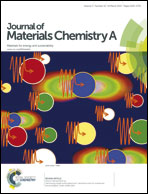New challenge of metal–organic frameworks for high-efficient separation of hydrogen chloride toward clean hydrogen energy†
Abstract
Eleven metal–organic framework (MOF) based materials are employed for H2/HCl separation by real breakthrough experiment and molecular dynamic simulation method for the first time. Among these MOF samples, only MIL-101(Cr) and UiO-66 are regenerable and present extremely high working capacity for HCl adsorption up to 7.67 mmol g−1 with unprecedented separation coefficient up to 1363. The dynamic adsorption and separation of H2/HCl on UiO-66 and MIL-101(Cr) afford clean hydrogen energy resource with a purity of 99.997%.


 Please wait while we load your content...
Please wait while we load your content...